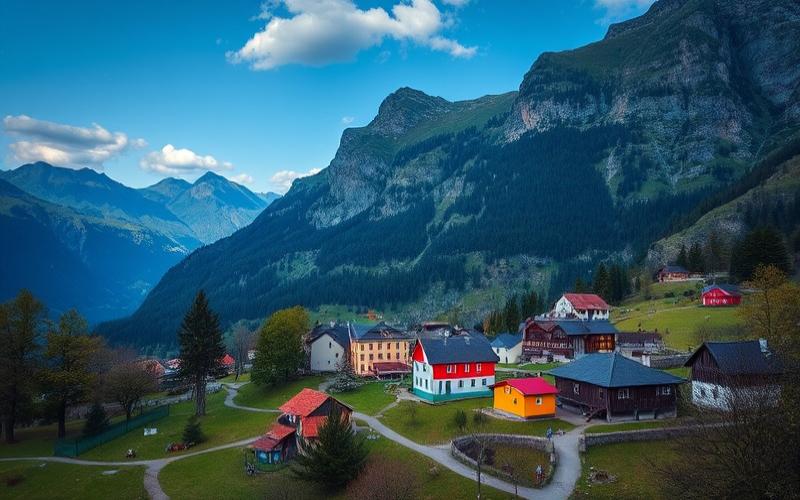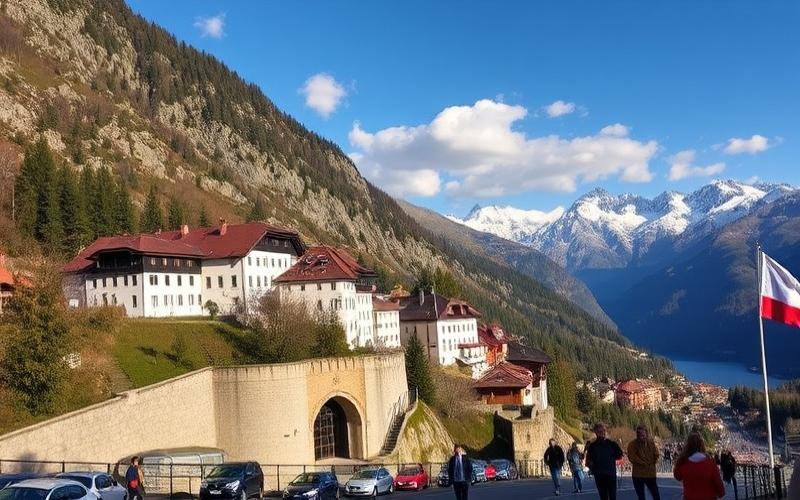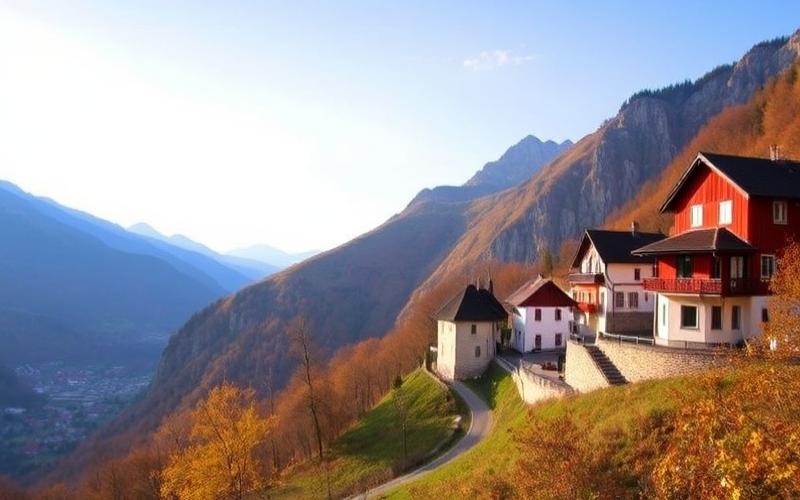
 Published on and written by Cyril Jarnias
Published on and written by Cyril Jarnias
Discovering Liechtenstein’s Public Transportation
Nestled between Switzerland and Austria, the Principality of Liechtenstein, though small in size, boasts a remarkably efficient public transportation system. This practical guide aims to reveal the secrets of bus travel, the primary mode of public transport, seamlessly connecting picturesque mountain towns to lush valleys.
Transportation Schedules and Fares
Through a detailed analysis of schedules, fares, and various ticketing options such as cost-effective passes, visitors and residents can effortlessly navigate throughout the entire country.
Good to Know:
Set off to discover some of the most beautiful attractions in this enclave with an ease that makes your travels both practical and economical.
Exploring Different Modes of Transportation in Liechtenstein
The main mode of public transportation in Liechtenstein is the bus, operated by LIEmobil.
- The LIEmobil network includes 25 bus lines covering the entire national territory as well as extensions to Switzerland (Sargans, Buchs) and Austria (Feldkirch).
- The network serves 411 stops, providing extensive coverage of main municipalities such as Vaduz, Schaan, Balzers, Triesen, and Ruggell.
- Coordination at the Schaan-Vaduz bus terminal allows passengers to quickly switch lines thanks to synchronized arrival and departure schedules.
| Main Company | Number of Lines | Number of Stops | Vehicle Types |
|---|---|---|---|
| LIEmobil | 25 | 411 | Gas & Diesel Buses |
Frequency and Accessibility:
- Buses run with high frequency during peak hours in main localities; some lines also offer night service.
- Schedules are adapted to ensure efficient connections with Swiss and Austrian trains at border stations (Sargans, Buchs, Feldkirch).
- Network accessibility is enhanced by compatibility with the Swiss Travel Pass for foreign visitors.
International Connectivity:
Regular services connect the country to Switzerland and Austria via several major border points.
List of Direct Cross-Border Connections:
- Sargans (CH)
- Buchs SG (CH)
- Feldkirch (AT)
Soft Mobility: Biking and Infrastructure
Liechtenstein has a growing network of cycling infrastructure connecting its main municipalities.
Initiatives Promoting Cycling:
- Continuous development of bike paths
- Promotion of cycling as an eco-friendly alternative for daily commutes
Private Cars:
Car usage remains common in rural areas or those with limited bus service.
Main Roles:
- Complementarity with public transportation
- Essential in some less accessible villages
National policy aims to encourage sustainable mobility.
Notable Actions:
- Significant public subsidies for the LIEmobil network operation to ensure affordable fares
- Campaigns to promote bus usage among residents as an alternative to private cars
- Gradual development of the vehicle fleet towards cleaner energy sources
Good to Know:
Liechtenstein offers several modes of transportation, although public buses form the core of the public transport network. Operated mainly by LIEmobil, the bus network is frequent with lines connecting the country’s main cities, while also ensuring connections with Switzerland and Austria. These buses are well-equipped for use by everyone, with particular attention to accessibility. Beyond public transport, numerous bike paths are available, promoting cycling as an eco-friendly alternative. In some areas, especially rural ones, cars remain a preferred mode of transport due to limited bus access. The country encourages sustainable mobility with initiatives promoting public transport and electric vehicles to reduce environmental impact.
Public Transportation Budget for Expatriates
Typical Public Transportation Costs in Liechtenstein
The main mode of public transport for expatriates in Liechtenstein is the LIEmobil bus network, which serves all municipalities in the country as well as cross-border connections to Switzerland and Austria.
| Pass Type | Standard Fare (CHF) | Reduced Fare (youth, seniors, disability recipients) (CHF) |
|---|---|---|
| Individual Annual Pass | 520 | 370 |
| Impersonal Annual Pass | 740 | – |
| Family Annual Pass | 740 | – |
| Individual Monthly Pass | Approx. 52* | Approx. 37* |
*Estimate based on monthly/annual rate ratio; verify at purchase.
Specific Discounts:
- Youth until the day before their 25th birthday, seniors from age 65, and disability recipients benefit from a reduced fare.
- Accompanied children before their sixth birthday travel for free.
- With certain Swiss passes (“GA pass”), it’s possible to travel for free or at a reduced rate on the LIEmobil network.
- Special passes exist for dogs and bikes (80 CHF/year each).
Concrete Monthly Expense Examples:
For an active adult using the bus daily: Typical expense with annual pass = CHF 520 / year ≈ CHF 43 / month Typical expense with monthly pass = CHF ~52 / month For a student or senior = CHF ~31/month with reduced annual pass
Comparison with Neighboring Countries
| Country | Monthly Adult Price (CHF) |
|---|---|
| Liechtenstein | ~52 |
| Switzerland | From CHF 355/month for national general pass; regional cheaper but often higher than Liechtenstein’s |
| Austria | From EUR 39/month in some regions, but fares vary significantly by zone |
Public transportation in Liechtenstein is therefore competitive compared to Swiss national offers and remains accessible compared to Austrian regional fares.
Summary List of Benefits:
- Advantageous fares especially with annual passes.
- Substantial discounts for youth, seniors, families.
- Free travel for accompanied children
Practical Tips to Optimize Your Trips
Tips for Efficiently Using Public Transportation in Liechtenstein
Trip Planning
- Use mobile apps such as SBB Mobile (Switzerland) or Rome2Rio to check real-time bus and train schedules, plan your routes, purchase e-tickets, and receive notifications about potential delays.
- Regularly check schedules, especially for the Buchs-Schaan-Vaduz rail section which has low frequency despite a very short duration. Trains are generally punctual but it’s advisable to confirm the day’s schedule before departure.
| Application | Main Features |
|---|---|
| SBB Mobile | Real-time schedules, ticket purchase |
| Rome2Rio | Multimodal routes |
| unterwegs.sob.ch | Seat reservations |
Optimal Schedules
- Prefer traveling outside local peak hours (generally between 7:30-9:00 AM and 4:30-6:00 PM) to avoid crowds on buses and at stations.
- Connections with Switzerland are frequent during the day; always check the exact schedule of the last train or bus if planning a late return.
Pass & Discount Tips
- Inquire about regional or cross-border passes that cover both Liechtenstein and certain neighboring Swiss or Austrian areas: they often allow significant savings during extended stays.
- Reduced fares exist for students, seniors, or groups; always ask about these options when purchasing.
Quick list:
- Purchase a weekly/monthly pass if staying several days.
- Take advantage of the Swiss Travel Pass which includes some trips on the Liechtenstein network.
- Check with the local ticket office for available seasonal offers.
Familiarizing Yourself with the Local Network
- The main network relies on a modern fleet of buses serving all important municipalities as well as Schaan-Vaduz (main station).
- Regular connections exist to Buchs SG (Switzerland), Feldkirch (Austria), and Sargans – strategic points for quickly reaching Zurich, Innsbruck, or Munich by international train.
| Connection | Mode | Frequency | Estimated Time |
|---|---|---|---|
| Schaan-Vaduz ↔ Buchs SG | Train/Bus | Multiple/day | ~3 min/15 min |
| Vaduz ↔ Feldkirch | Bus | Hourly | ~30 min |
Newcomers and tourists alike are recommended to take a few minutes upon arrival to study the network map displayed at each main stop.
Traveling Ecologically
- Systematically favor bus/train over private cars: direct reduction of polluting emissions.
- Also prefer cycling combined with public transport thanks to numerous secure bike parking near main stations.
Ecological recommendations:
- Limit single-use paper tickets: prefer e-tickets via mobile app.
- Walk between two nearby stops when possible – Vaduz being an excellent pedestrian capital.
Integrating Tourism & Daily Commutes
- Organize your daily itinerary around major lines: many attractions are on or near the regular Vaduz-Balzers-Triesenberg route.
- Take the opportunity to visit national museums, the princely castle, or marked trails without multiplying unnecessary motorized trips.
Practical list:
- Start your visits early to avoid tourist crowds while better enjoying regular morning/midday service.
- Combine daily shopping with cultural breaks: numerous artisan shops accessible from each central stop.
Essential tip: Learn a few common useful German words (“Fahrplan” = schedule; “Umsteigen” = transfer; “Haltestelle” = stop). This will greatly facilitate your requests to local staff and quick understanding of directional signs!
Good to Know:
To optimize your public transportation trips in Liechtenstein, start by using mobile apps like SBB Mobile or Ostwind to plan your travels and avoid peak hours, typically between 7-9 AM and 5-7 PM. Take advantage of pass cards such as the Tageskarte Gemeinde or Lie-Mobil-Card which offer discounts on trips. Familiarize yourself with the bus network and rail connections to Switzerland and Austria, which are essential for cross-border travel. For more ecological travel, prefer cycling combined with public transport. Tourists can integrate historical sites like Vaduz Castle into their daily itineraries by checking bus lines leading to these attractions.
Disclaimer: The information provided on this website is for informational purposes only and does not constitute financial, legal, or professional advice. We encourage you to consult qualified experts before making any investment, real estate, or expatriation decisions. Although we strive to maintain up-to-date and accurate information, we do not guarantee the completeness, accuracy, or timeliness of the proposed content. As investment and expatriation involve risks, we disclaim any liability for potential losses or damages arising from the use of this site. Your use of this site confirms your acceptance of these terms and your understanding of the associated risks.
























